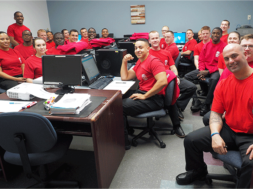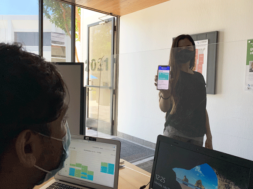
What’s an EOP?
By Tami Erickson, Ph.D., Vice President Accreditation & Licensure, Ancora Education, Inc.
What’s an EOP? It is an Emergency Operations Plan (EOP), also referred to as an Emergency Response Plan or Emergency Action Plan. Most companies or organizations should have one. Institutions of higher education may be required to have an Emergency Operations Plan based upon their accreditation standards.
The purpose of an EOP is to provide a safe campus environment for students, staff, faculty, and guests through a written, proactive, and systematic plan of action that should be followed in the event of an emergency.
It provides written documentation and a centralized location of guidelines and processes that all individuals can reference prior to an emergency. This can help to reduce injuries, stress, and increases the safety of each individual on the campus should a situation actually occur.
When writing an Emergency Operations Plan, it is important to have a variety of individuals from different campus positions and outside groups involved in the process. One person is assigned as the project manager to coordinate the EOP, but not to produce the entire document alone. Rather a cross-section of employees from different campus functions such as the director of education, a program chair, faculty, and a staff member (financial aid officer, career services specialist) should be involved in the process. Often times, including a student representative from the Student Council is helpful because they know where students often like to study or “hang out” that may not be the most common areas. A campus may even consider inviting a local first responder to participate in drafting or reviewing the EOP. Insurance companies may be of help in drafting the Emergency Operations Plan as well since they can provide a monetary risk prevention perspective. By having this cross-section of individuals participate in writing the EOP it allows for different perspectives and experiences to be captured for a more comprehensive and effective plan.
There are eight main sections every Emergency Operations Plan should include at a minimum:
1. Contact information
2. Emergency operations team
3. Evacuation maps
4. Levels of emergencies
5. Reporting of an emergency
6. Most common emergencies
7. Emergency notification
8. On-going process
Contact information
The first section is to identify the basic contact information for those who may be needed during an emergency. Important contact information such as the phone number, email and websites for the local police and fire departments, emergency medical teams, utility companies, poison control, and campus leadership would be required. If the campus space is rented or leased include the contact information of the landlord or property manager. Contact information to local television and radio stations are a must have in case of an emergency so that if the campus must be shut down for any reason, these sources may get the word out quickly. If you contract with a student notification system provider you may also want to include that information to facilitate student notifications.
Emergency operations team
The second section is to identify an Emergency Operations Team (EOT). The EOT is a group of individuals on campus who prepare for and respond to an emergency incident that interrupts the normal course of business operations such as a fire, bomb threat, active shooter or weather evacuation.
Like the writing of the Emergency Operations Plan, the Emergency Operations Team should be spread across the different campus function groups and be located in different areas of the campus.
Appoint one or two members who will communicate with first responders and who would give the “all clear” notification when it is safe to reenter a building or return to regular activities. These team members receive on-going special training in how to handle the reporting of an incident, evacuation procedures, crowd control, temporary relocation of operations, and lock-in-place procedures.
Evacuation routes
Once an Emergency Operations Team has been identified, your focus should move to section three – evacuation routes. These are maps with routes marked from each specific location, such as an office, common areas, restrooms, and classrooms to the designated evacuation area. The evacuation map must include the exit routes designated by arrows, restrooms, electrical rooms, non-exit locations and meeting places once outside the building. Evacuation meeting places should be at least 500 feet from the building and not block an entrance where first responders would need to enter a driveway or building. They should also be posted in every room of the building and must reflect the exit route from that unique room. More robust plans would include pertinent tips such as:
• Information about not using elevators;
• Leave belongings behind;
• Closing doors once a room is clear of people;
• Walking swiftly but safely to the nearest exit; and
• Not to reenter the building until receiving an “all clear.”
Levels of emergencies
The next section would define the level of the emergency. Low level or minor emergency issues are defined as an incident that does not affect the ability to conduct “business as usual.” This might be something like a medical issue, a fight between two students or a stolen car. Medium level or major level is an incident that impacts one area of campus but not the entire facility as a whole. Examples include an unidentified foul odor from a room, circuit breaker outage, or water pipe break. The high level of disaster is an emergency that seriously impairs the ability to do business, such as an earthquake, weather-related issues, widespread fire or intruder with the intent to produce harm.
Reporting of an emergency
Section five is to explain how students, staff, and faculty are to report an emergency. For low level emergencies, a student or staff member may be able to simply report to a faculty member, who in turn reports the incident to a manager who has appropriate training to take the next steps to resolve the situation. For a medium level emergency, if the campus has a Security Department, the report would go directly to that department, who then responds accordingly. If the campus does not have a Security Department, the report would go to a higher-level manager on campus. If there is a disaster, anyone on campus should have the ability and knowledge to simply dial 9-1-1 for help.
Most common emergencies
The sixth section will be the longest most detailed part of the EOP and include numerous sub-sections. It will give specific policies and procedures to follow for the most common potential emergency occurrences that could impact the campus. It is the “what to do if” section. As well as, other general emergency information. Common topics to include are poison control, gas leaks, explosions, fires (trash can vs widespread), water and power outages. Other topics may include an exposure control plan, mental health emergency (someone trying to harm themselves) and general cybersecurity breach plan. Section six would include weather-related situations most common in the local area in which the campus resides. For example, detail procedures on what to do if there is a tornado, but not hurricanes if your campus is not in an area where hurricanes are common. More advanced plans would include a sub-section for general emergency procedures such as how to help individuals with disabilities or injured individuals evacuate a building, the use of an Automated External Defibrillators (AED), and tips to avoid panic.
Emergency notification
Section seven covers when to send campus emergency notifications and/or timely warnings. It will identify who is responsible for sending the messages. How these notifications will be delivered via text message, email, and/or on the campus website. Explain what communication will go out to students, staff, faculty, and potentially the neighboring community based on the level of the emergency. Have draft language prepared in order to make it easy in an emergency to copy and paste. For example, “Campus will be closed today, xx/xx/xx, due to snowy conditions. Please stay tuned for further instructions tomorrow.” This section also provides information about what local television, radio stations, and website locations campus emergency notifications will be broadcast.
On-going process
To conclude the Emergency Operations Plan, the last section (eight) describes how often fire drills and other types of drills (such as earthquake, common weather occurrences and lock-down) will be conducted throughout the year. These practice drills must include students, staff and faculty. They should also be held for each shift that occurs during the day and evening to ensure everyone has the opportunity to participate at least once. The plan should detail if and when these drills are announced or unannounced. Documentation of the drills should be kept on record for seven years. This section should include a statement that the Emergency Operations Plan is reviewed and updated at least annually. It will also provide guidance as to what types of training are offered to students and staff/faculty, where to find more information and provide feedback.
Including these eight sections will give any campus leadership a solid foundation to begin writing an effective Emergency Operations Plan.
If a campus already has an established EOP, these may be good reminders to double check, and to make updates to ensure a safe campus environment. Reviewing another local school’s EOP may also be helpful to ensure that you have remembered to include all applicable types of emergencies. Having an Emergency Operations Plan, reviewing it often, and practicing the procedures and drills in the plan will reduce chaos in the event that an emergency does happen.
TAMI ERICKSON, PH.D. has 19 years’ experience in higher education. She has experience with academics, admissions, student services, teaching, and online education. Most of those 19 years, however, have been spent in the for-profit higher education compliance arena related to regulatory, accreditation, Title IV and safety oversight. Currently, Dr. Erickson is the Vice President – Accreditation & Licensure with Ancora Education. She holds a Ph.D. in Leadership Studies and a Master’s in Public Administration. She is also involved with a variety of Texas Historical Associations, Accrediting Commission of Career School and Colleges, Accrediting Bureau of Health Education Schools, Accrediting Council for Independent Colleges and Schools, Council on Occupational Education and has cultivated relationships with many state agencies that impact the career school sector. Dr. Erickson is often found speaking on a variety of topics related to higher education at conferences across the United States.
Contact Information: Tami Erickson, Ph.D. // Vice President Accreditation & Licensure // Ancora Education // 817-825-4491 // terickson@ancroaeducation.com // https://www.linkedin.com/in/ericksontami/











